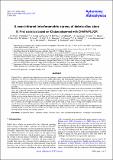A near-infrared interferometric survey of debris disc stars : III. First statistics based on 42 stars observed with CHARA/FLUOR
Abstract
Context. Dust is expected to be ubiquitous in extrasolar planetary systems owing to the dynamical activity of minor bodies. Inner dust populations are, however, still poorly known because of the high contrast and small angular separation with respect to their host star, and yet, a proper characterisation of exozodiacal dust is mandatory for the design of future Earth-like planet imaging missions. Aims. We aim to determine the level of near-infrared exozodiacal dust emission around a sample of 42 nearby main sequence stars with spectral types ranging from A to K and to investigate its correlation with various stellar parameters and with the presence of cold dust belts. Methods. We use high-precision K-band visibilities obtained with the FLUOR interferometer on the shortest baseline of the CHARA array. The calibrated visibilities are compared with the expected visibility of the stellar photosphere to assess whether there is an additional, fully resolved circumstellar emission source. Results. Near-infrared circumstellar emission amounting to about 1% of the stellar flux is detected around 13 of our 42 target stars. Follow-up observations showed that one of them (eps Cep) is associated with a stellar companion, while another one was detected around what turned out to be a giant star (kap CrB). The remaining 11 excesses found around single main sequence stars are most probably associated with hot circumstellar dust, yielding an overall occurrence rate of 28+8-6 for our (biased) sample. We show that the occurrence rate of bright exozodiacal discs correlates with spectral type, K-band excesses being more frequent around A-type stars. It also correlates with the presence of detectable far-infrared excess emission in the case of solar-type stars. Conclusions. This study provides new insight into the phenomenon of bright exozodiacal discs, showing that hot dust populations are probably linked to outer dust reservoirs in the case of solar-type stars. For A-type stars, no clear conclusion can be made regarding the origin of the detected near-infrared excesses.
Citation
Absil , O , Defrère , D , Coudé du Foresto , V , Di Folco , E , Mérand , A , Augereau , J -C , Ertel , S , Hanot , C , Kervella , P , Mollier , B , Scott , N W , Che , X , Monnier , J D , Thureau , N D , Tuthill , P G , ten Brummelaar , T A , McAlister , H A , Sturmann , J , Sturmann , L & Turner , N 2013 , ' A near-infrared interferometric survey of debris disc stars : III. First statistics based on 42 stars observed with CHARA/FLUOR ' , Astronomy & Astrophysics , vol. 555 , A104 . https://doi.org/10.1051/0004-6361/201321673
Publication
Astronomy & Astrophysics
Status
Peer reviewed
ISSN
0004-6361Type
Journal article
Description
The authors thank the French National Research Agency (ANR) for financial support through contract ANR-2010 BLAN-0505-01 (EXOZODI). O.A. acknowledges financial support from the European Commission’s Sixth Framework Programme as a Marie Curie Intra-European Fellow and from an F.R.S.-FNRS Postdoctoral Fellowship during part(s) of this work.Collections
Items in the St Andrews Research Repository are protected by copyright, with all rights reserved, unless otherwise indicated.

